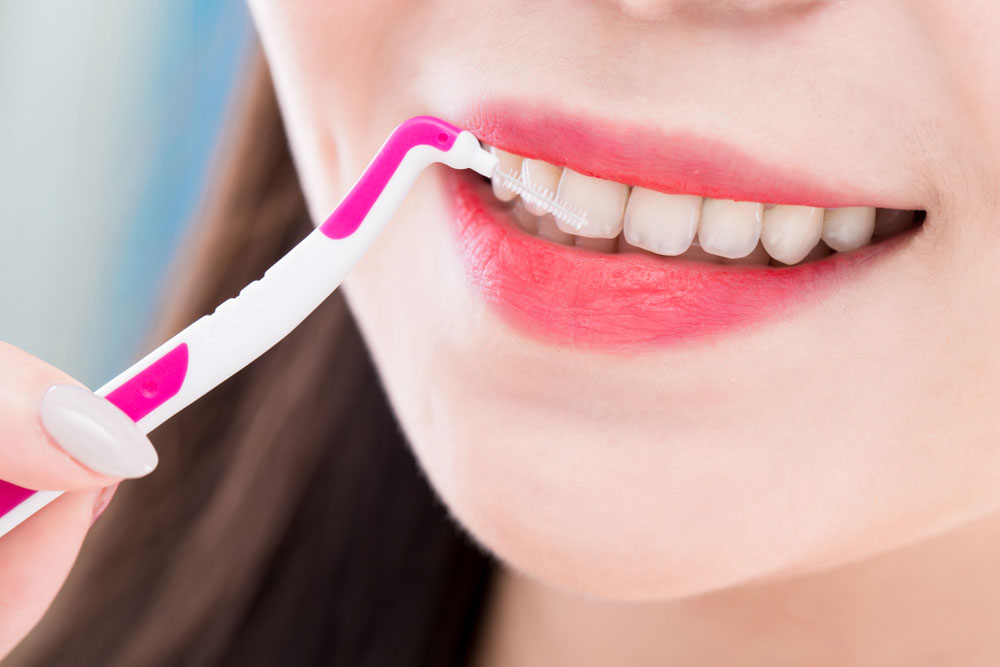
It’s the question that everyone dreads hearing when they visit their dentist: “So, have you been flossing your teeth every day?” You try to make a mumbled no somehow sound like a yes to avoid the proceeding diatribe about why you should be flossing every single day. And of course, you know you should be flossing, but the process of using string floss is such a nuisance. Right?
Enter interdental brushes.
This new-age flosser is a thin wire that can fit between the crevices of your teeth. Surrounding the wire are brush thistles that scrub bacteria from the enamel. In theory, this tool sounds great—it’s like a mini toothbrush for those hard to reach places. But to explore more, this article is going to be tackling everything from what are interdental brushes used for to their efficacy when juxtaposed against other various forms of flossing.
What Do Interdental Brushes Do?
Interdental brushes act like tiny 360-degree toothbrushes that can reach the small opening between teeth. Because this is an area that is hard to access with a traditional toothbrush, these smaller wire brushes come in handy.
However, just because it’s convenient doesn’t mean it’s effective in optimizing your oral health. To determine this, let’s compare it with the other forms of flossing.
Various Forms of Flossing
Over the last ten years, you’ve probably seen many different products attempt to answer the flossing problem. The commonly known floss methods are:
- String floss – Both waxed and unwaxed string floss have been the traditional go-to flosser since its first invention in 1815. String floss is great for removing large food particles; however, it can result in gum damage and inflammation when it is used forcefully. Plus, it doesn’t necessarily clean the entire gum area and proves less effective toward the back of the mouth around the molars.
- Dental floss pick – Dental floss picks are thought to be a better design than traditional string floss. By holding onto a plastic handle, you can more effectively target hard to reach areas of the mouth. However, it essentially has the same efficacy for cleaning the gums as string floss. Great for large particles, less so for micro bacteria and plaque.
- Water flosser – Water flossers use a stream of water (or mouthwash) to clear away trapped food particles and bacteria from between the teeth. It is a gentler and more effective means of cleaning interdentally than string floss.
How do these forms of flossing stack up against interdental brushes?
Efficacy of the Different Flossers
While it may come as no surprise, string flosses are the weakest of the bunch when it comes to their effectiveness in preventing gum disease, removing plaque, and preventing bad breath. Interdental brushes were shown to be an effective alternative to regular floss for the reduction of bleeding gums and plaque.1 But how does it stand up against water flossers?
In a single-use study comparing interdental brushes and water flosses, the group who had access to the water flosser had removed “significantly more plaque from tooth surfaces (whole mouth, marginal, approximal, facial, and lingual)” than those who used the interdental brush.2
The reason why water flossers are thought to be superior is because of their total coverage of tooth surfaces and gums alike. Liquid streaming through the crevices between the teeth allows all surfaces to be adequately scrubbed clean. And when mouthwash is used within the flosser, the bacteria are completely removed.
Do Interdental Brushes Cause Bleeding Gums?
This is a common question revolving all flossers.
In short, interdental brushes aren’t what’s causing the gums to bleed. Bacteria that cause gum inflammation and gums to be irritated and swollen create an environment where gums will bleed. If your gums are healthy and properly taken care of, they will not bleed when you floss or use an interdental brush.
It should be noted, however, that if you do experience bleeding consistently, you should consider a gentler form, like water flossing. The Toothshower was designed to be an effective form of flossing that’s milder on the gums.
Why Flossing is Necessary
Regardless of which flosser you choose, the one point all the above have in common is that they should be used daily. The bacteria that are primarily responsible for tooth decay are able to create a hardened shell that remains stuck on your teeth. This is what’s known as plaque.
Plaque, left unattended, will only be able to be removed by a dentist or professional oral hygienist. To avoid this and prevent tooth decay from happening, you need to be diligent about flossing each day.
Most Effective Flosser
If you’re using string floss, any of the alternative flossers mentioned above will be an upgrade to your oral hygiene routine. And interdental brushes will definitely offer a significant boost to your gum health.
However, to optimize your interdental cleaning, the water flosser has the most effective results. That’s why Toothshower created a water flosser that could be installed directly into your shower. When you take your daily shower, now you can do your daily flossing too and help to prevent Gingivitis, tooth decay, and a number of other dental conditions.
Plus, when the dentist asks you that dreaded question again, now you can answer truthfully and confidentlythat you are brushing and flossing every day.
Happy flossing!
Sources:
- NCBI. Comparison of interdental brush to dental floss for reduction of clinical parameters of periodontal disease: a systematic review. https://www.ncbi.nlm.nih.gov/books/NBK99431/
- NCBI. Comparison of Water Flosser and Interdental Brush on Plaque Removal: A Single-Use Pilot Study. https://www.ncbi.nlm.nih.gov/pubmed/28390213
The post What Are Interdental Brushes? appeared first on ToothShower.

Leave a comment (all fields required)